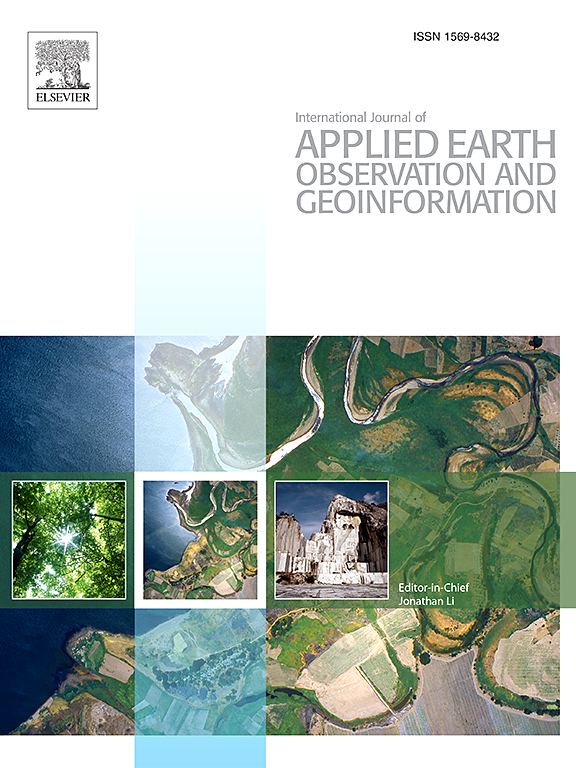Advancing sustainable agricultural: A novel framework for mapping annual 30-m resolution national-level irrigated croplands
IF 7.6
Q1 REMOTE SENSING
International journal of applied earth observation and geoinformation : ITC journal
Pub Date : 2025-05-16
DOI:10.1016/j.jag.2025.104589
引用次数: 0
Abstract
With regard to climate change and population growth, irrigated croplands need to be accurately delineated for sustainable water resource management. Owing to the lack of extensive training samples and the limitations of coarse spatiotemporal resolution data in complex agricultural regions, China’s irrigated croplands are difficult to map with a unified spatiotemporal framework. This study presents an innovative method for mapping irrigated and rainfed croplands in mainland China with a local adaptive random forest classifier on the Google Earth Engine platform. Based on the dynamic threshold extraction of multiple peak vegetation index values and a rigorous multi-dataset integration strategy, the annual sample sets of irrigated and rainfed croplands are generated automatically. After constructing 147 multi-feature variables sensitive to irrigation activities, China’s annual irrigated croplands dataset (CAICD) is developed, with 30-m spatial resolution for the 1990–2022 period. The results show the following:(1) CAICD has higher accuracy and a more realistic spatial distribution of irrigated croplands compared with existing datasets, with an average overall accuracy of 0.80. (2) The most sensitive classification features for irrigation signals are spectral indices and original bands, with regional differences influenced by climate characteristics (precipitation and evapotranspiration) and terrain features. (3) Over the past three decades, China’s irrigated croplands have expanded overall and Xinjiang has exhibited the most significant increase and the highest growth rate of irrigated area in mainland China, with an annual expansion of 103 thousand hectares. The results exhibit significant implications for the balance between food security and water resource security, providing valuable insights and contributions for future global monitoring of irrigated croplands.
推进可持续农业:绘制年度30米分辨率国家级灌溉农田的新框架
在气候变化和人口增长方面,需要准确划定灌溉农田,以便进行可持续的水资源管理。由于缺乏广泛的训练样本和复杂农业区的粗糙时空分辨率数据的限制,中国灌区难以建立统一的时空框架。本研究提出了一种基于谷歌Earth Engine平台的本地自适应随机森林分类器在中国大陆灌溉区和旱作区进行地图绘制的创新方法。基于多峰植被指数的动态阈值提取和严格的多数据集整合策略,自动生成灌区和旱地的年度样本集。在构建147个对灌溉活动敏感的多特征变量后,构建了1990-2022年中国灌溉农田年数据集(CAICD),其空间分辨率为30 m。结果表明:(1)与现有数据集相比,CAICD具有更高的精度和更真实的灌溉农田空间分布,平均总体精度为0.80;(2)灌溉信号最敏感的分类特征是光谱指数和原始波段,区域差异受气候特征(降水和蒸散发)和地形特征的影响。(3)近30年来,中国灌区面积总体呈扩大趋势,其中新疆灌区面积增长最为显著,年均增长10.3万公顷,是中国大陆灌区面积增长最快的地区。研究结果对粮食安全和水资源安全之间的平衡具有重要意义,为未来全球灌溉农田监测提供了有价值的见解和贡献。
本文章由计算机程序翻译,如有差异,请以英文原文为准。
求助全文
约1分钟内获得全文
求助全文
来源期刊

International journal of applied earth observation and geoinformation : ITC journal
Global and Planetary Change, Management, Monitoring, Policy and Law, Earth-Surface Processes, Computers in Earth Sciences
CiteScore
12.00
自引率
0.00%
发文量
0
审稿时长
77 days
期刊介绍:
The International Journal of Applied Earth Observation and Geoinformation publishes original papers that utilize earth observation data for natural resource and environmental inventory and management. These data primarily originate from remote sensing platforms, including satellites and aircraft, supplemented by surface and subsurface measurements. Addressing natural resources such as forests, agricultural land, soils, and water, as well as environmental concerns like biodiversity, land degradation, and hazards, the journal explores conceptual and data-driven approaches. It covers geoinformation themes like capturing, databasing, visualization, interpretation, data quality, and spatial uncertainty.
 求助内容:
求助内容: 应助结果提醒方式:
应助结果提醒方式:


